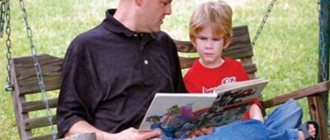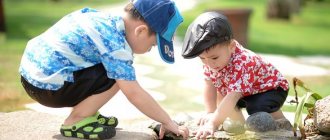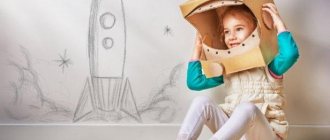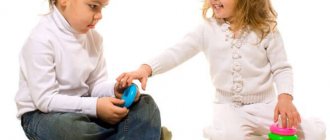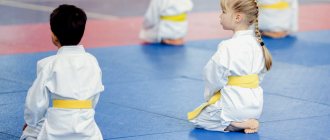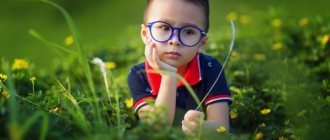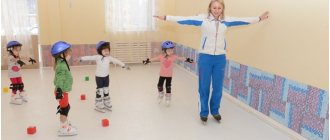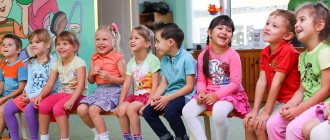What are fine motor skills in children?
“The White-sided Magpie,” “The Horned Goat is Coming,” “Ladushki-Ladushki”—every mother knows these nursery rhymes. And any baby loves it when his mother runs her index finger over his palm, bends and straightens her fingers, and reads a rhyme. It seems that there is nothing special in this game. But in fact, this is one of the simplest ways to develop fine motor skills in children, known to many generations of parents.
Fine motor skills are fine movements of the hands and fingers. How deftly a child in early childhood builds towers from cubes, dresses a doll and wields a spoon while eating depends precisely on the development of fine motor skills of the hands. A preschooler will show his level of hand skills by tying his shoelaces before a walk, gluing an applique for his mother for March 8th, and assembling a construction set from small parts. The teacher will quickly figure out an untrained first-grader from the first copybooks: if a child preferred football to mosaic, then his handwriting, as a rule, is worse.
Therefore, it is better to start preparing a child’s hand in time for complex and delicate operations, and a child for adult life.
Fine motor skills in children are the basis for the development of mental processes such as attention, memory, perception, thinking and speech. Developing it is important for children of any age. Almost everything a small child does (except for outdoor games) is operations with objects, through which he not only learns their properties and purpose, but also gets acquainted with the world as a whole. Therefore, it is important to offer him a wide variety of fine motor activities.
Let's see what kind of activities these are and what games and toys for hand motor skills will be useful to us.
By the way, “Agusha” fruit puree in sippy packaging is specially designed so that the baby can practice fine motor skills by unscrewing and screwing the cap and squeezing the puree in the gently rustling packaging in his hands.
It is necessary to develop fine motor skills in a child from early childhood. Fortunately, this is not difficult at all. Let's list the simplest and most accessible means (in order of the child's maturation).
Hand development norms
After 3 years, children’s motor skills become more complex and varied: the percentage of actions that require coordinated hand movements from the child increases.
What should children of this age be able to do in terms of developing fine motor skills?
- To hold objects, they increasingly use their fingers, rather than the palm, as before.
- Able to hold a pen or pencil.
- They can draw lines, circles, polyhedra, redraw crosses and squares.
- They know how to cut paper shapes with scissors.
- Can take off and put on clothes and shoes.
- Grab small objects or parts with your thumb and index finger.
- Build a tower with at least 3 cubes.
- Draw a person consisting of at least 3 elements (head, torso, limbs).
- Take out small objects from a transparent container.
- Unscrew the lids.
- String beads onto wire.
- They can draw with their fingers.
- Scoop the cereal into a spoon from one container to transfer it to another.
- Trace the outline along the dotted line.
- Simple elements are molded from plasticine.
- Fasten and unfasten zippers, clasps, snaps, buttons.
- Sorting small items and cereals.
- Unwrap candy wrappers.
- They tie knots.
- Hand movements occur through coordination with vision.
All these skills need to be developed and improved, preparing little hands for increasingly complex and precise manipulations.
If your baby does not yet know how to do something from this list, it is important to fill this gap in a timely manner. Teach him age-appropriate skills, otherwise he will have problems later: he will have to not only learn new skills, but also catch up with his peers where he lags behind. And this is more difficult.
From 8 months: inserts
- Cups, jars, bowls, nesting dolls, children's toy dishes. Any household items (safe for the child), varying in size, which the baby will endlessly “test for compatibility”: assemble, disassemble, insert, lay out, knock them against each other. “I’m developing fine motor skills, mom, be patient!” Can be offered to a sitting child from 6 months.
- Boxes, jars with lids, bags - the baby learns to open and close.
- Sorters (boxes with slots of different configurations and elements of the appropriate size and shape). Wooden, plastic, round, square, in the shape of dogs or boats - whatever you like. They usually become a favorite pastime no earlier than 8–9 months. You can do without a purchased toy. A clean shoe box made of thick cardboard, windows cut out with scissors and objects of appropriate shape (large buttons and beads, cubes, etc.) - the baby will be busy with them for a long time. You'll even have time to wash your hair or drink your morning coffee (we can't promise everything at once!).
- Twisting and unwinding. Caps, lids, toy screws - everything that can be screwed on or turned in one direction or the other. It is not necessary to buy special sets - just offer your baby a plastic bottle with a lid or a plastic thermos.
- Wooden cubes, pyramids, abacus, knockers with hammers, construction sets, simple musical toys, insert frames. They satisfy the baby's cognitive interest, develop spatial orientation and - what is most important for us now - improve small hand movements, develop coordination and dexterity.
Consultation “Development of motor skills and physical activity”
Svetlana Linenko
Consultation “Development of motor skills and physical activity”
Development of motor skills and physical activity
A child’s interaction skills with objects in the surrounding world are determined primarily by the level of his control of his own body, the degree of involvement in social interaction and the level of his own activity , initiative and curiosity. Motor dexterity and the variety of actions performed with objects depend on the child’s temperamental characteristics and on the permissive behavior of society. After all, in order for a child to learn to climb up a vertical ladder and slide down a steep slide or dive headfirst into water from a height, he must not only be motorically developed enough for this and want to do it , but he must also be allowed to do it. Consequently, there are individual differences in the development of motor skills in a child, but at the same time there is a certain “limit”
of this
development (for example, not many European children develop advanced tree climbing skills, which not many children can climb higher than.
Development of the "body diagram"
develops , he learns not only external objects, but also his own body and the “body diagram”
how the mental structure continues to form and improve.
In this regard, along with role-playing games and games according to the rules, children can engage in activities that are meaningless in the eyes of adults: splashing with water for a long time, throwing pebbles at a target, tasting plants, playing with animals, running, jumping, squatting , spinning around in one place, “racing”
a bicycle, messing with each other, pretend fight.
During these games, children receive new sensations, as a result of which their motor skills and movements become more coordinated.
Age norms
A three-year-old child, when walking and running, places his legs much closer to each other, takes objects with one hand, he maintains balance better, moves more smoothly and dexterously.
Four-year-old children can already change the rhythm of running and jumping. They demonstrate greater strength, endurance and coordination of movements than three-year-olds. Can draw simple shapes and figures with a pencil; paint; made from building blocks. They can put on and take off simple clothes and simply serve themselves at the table.
At five years old, children can already walk on a gymnastic beam, jump deftly, stand on one leg, can fasten buttons and zippers, and dress and undress independently. Some people know how to tie shoelaces.
At the age of six, some children are already so motorically dexterous that they begin to master professional activities - playing musical instruments , swimming, dancing, skating, etc.
Motor skills develop in a child in accordance with general, mainly cognitive activity . The motive that encourages a preschooler to manipulate objects is cognitive interest. It is cognitive interest and the formation of certain mental structures that makes children aged approximately five years “why”
. In this regard, it should be taken into account that ignoring the child’s questions about the world order that appear in him at this age can lead to the fading of his cognitive interest.
Movement has a comprehensive impact on the human body, and this is immeasurably important for a growing and developing child’s body .
Intense work of a large number of muscles when performing movements places high demands on the main functional systems and has a training effect on them. Under the influence of movements, the function of the cardiovascular and respiratory systems improves, strengthens the musculoskeletal system, and regulates the activity of the nervous system and a number of other physiological processes . With active movements , especially cyclic ones, breathing deepens and pulmonary ventilation improves. Active movements increase the child’s resistance to diseases, stimulate the mobility of the body’s defenses, and increase the activity of leukocytes. On the contrary, a lack of movement causes changes in the central nervous system, which can lead to emotional tension, instability, metabolic disorders in the body, as well as a decrease in the functionality of the cardiovascular and respiratory systems and, consequently, a decrease in the body’s performance.
Motor activity contributes to the development of children's mental abilities, perception, thinking, attention, spatial and temporal concepts.
While children perform movements, the teacher actively develops in them moral and volitional qualities, determination, perseverance, endurance, courage, etc.
It is especially important to support in children the desire and ability to overcome obstacles, independently choosing a method of action depending on the specific conditions that have developed at the moment.
When performing movements, it enriches the emotional state of children. They experience a feeling of joy, elation from the energy manifested when mastering motor actions, from the relaxedness and freedom of their implementation. Children perceive the beauty of joint friendly actions.
Motor activity for the development of the psyche and intellect is extremely great.
From working muscles, impulses gradually enter the brain, stimulating the central nervous system and thereby promoting its development . The more subtle movements a child has to perform and the higher the level of coordination of movements he achieves, the more successful the process of his mental development .
physical activity not only contributes to the development of muscle strength as such, but also increases the body’s energy reserves.
The work of skeletal muscles is of great importance for the development of a child's physiological systems . In a growing organism, the restoration of expended energy occurs with a significant excess, that is, a certain excess of it is created. That is why, as a result of movements, muscle mass develops , which ensures the growth of the body. But this is not just an increase in mass, this is a prerequisite for performing even greater volume and intensity loads.
Scientists have established a direct relationship between the level of motor activity of children and their vocabulary, speech development , and thinking. Under the influence of physical exercise and physical activity in the body, the synthesis of biologically active compounds , which improve sleep, have a beneficial effect on the mood of children, and increase their mental and physical performance .
In the scientific literature there is the concept of biological sufficiency of movements. Relatively speaking, this is the number of movements that are necessary for the normal development of the baby . Naturally, depending on the age, this number changes: the older the child, the greater the number of movements he must make for normal development .
Especially in the process of physical activity , it requires significant emotional stress from children, activation of all mental processes, and certain behavioral skills . Providing psychological comfort is the most important condition for the education of morality.
Children should not be required to achieve equally high results in movement and games, but only according to their abilities. We must be able to see the uniqueness of each child and give him the opportunity to feel complete freedom of expression. There are several effective techniques with which you can establish contact with children in physical education classes and outside of them: ensure an optimal load of physical activity , bring to the children’s consciousness the essence of each physical education exercise, ensure the goal setting of the upcoming lesson so that it is understood and accepted by each of the children . It must be remembered that games with movements and in movement are the happiest moments of a child’s life.
It is important to teach children to see and understand those around them, to coordinate their actions with their actions, to show empathy and support; help overcome obstacles at the right time; not laughing at someone who has fallen, shows uncertainty, inability .
Outdoor games are useful, in which a situation is created that increases interdependence on each other. Communication skills acquired in such situations are more easily transferred to other types of activities and normal life conditions.
For the diversified development of body functions, the combination of various types of movement is of particular value. The free use of sufficiently mastered skills in different situations creates more opportunities for children to display activity and creativity .
The level of development of basic motor qualities - agility, speed, endurance - allows the child to successfully master motor skills (running, jumping, throwing)
and sports exercises
(skiing, cycling, swimming)
.
The listed motor qualities also include muscle strength, that is, the ability to master movement. Without sufficiently developed strength , you cannot run, swim, or walk in place quickly and for a long time.
A strong, strong child easily learns new movements, he is self-confident, able to endure difficulties and even loves exercises with a greater load. It is especially important to achieve uniform development of the muscles of the flexors and extensors of the trunk and the upper key belt. These muscles ensure the normal functioning of internal organs. Weak muscles of the key belt make it difficult to develop normal posture.
For normal physical development of a child, it is necessary to monitor physical activity throughout the day .
By instilling in children the need to move daily and do physical exercise from an early age, you can lay a solid foundation for good health and harmonious development of the child .
References
1. Osorina M.V. The secret world of children in the space of the world of adults. 5th ed. – St. Petersburg: Peter, 2013. – 368 p.: ill. – (Series “Your own psychologist”
).
2. Potapchuk A. A. Diagnosis of child development . – St. Petersburg: Rech, 2007.-154 p.
3. Psychology of childhood / Ed. Corresponding member of RAO A. A. Rean. – St. Petersburg: Prime-EUROZNAK, 2008. – 350, [2] p.
4. Internet resources
From 1 year: natural materials
- Sand games: buckets, molds, shovel, Easter cakes. A lesson for several seasons. At first, your mother (grandmother, nanny) will make the molds. We recommend starting with large molds: with their help you can make even shapes without crumbling edges (any “imperfection” can make kids angry; they strive for ideals in everything).
- Plasticine, plastic clay, salt dough. We roll sausages, make koloboks, strings and glue them into a hoop. Such activities perfectly strengthen the muscles of the hand, make the fingers more dexterous and mobile, and expand the child’s ideas about his capabilities. At a later age, your child will proudly bring figurines of hedgehogs, bunnies and dogs from kindergarten classes, which will begin to settle on your bookshelves. You cannot treat them with disrespect - these are the first products of a child’s labor, he values them very much!
- Cones, pebbles, sand, pebbles, walnuts (in shell) and chestnuts. The latter are collected during a walk in the fall, stuffed into pockets, brought home and washed. Now it’s useful to knead them in your palms, two at a time, and rotate one around the other.
- Games with any bulk materials. The child puts his hands into a vessel with some homogeneous filler (sand, various grains, pellets, any small objects). Stirs the contents for a few minutes. Then he is offered a vessel with a filler of a different texture. After several trials, the child, with his eyes closed, puts his hand into the offered vessel and tries to guess its contents without feeling its individual elements with his fingers. At the same time we develop speech. Do this only under the supervision of an adult: small objects are not recommended for children under 3 years of age to play with.
Invite your child to play “Cinderella” - sort beans, peas, large beads, dry pasta of different colors into different containers.
From 1 year: first self-care skills
- Spoon, toothbrush, comb. By the age of one year, they definitely end up in the baby’s hand. They not only allow you to practice self-care skills, but also develop coordination and fine motor skills. By kindergarten we learn how to fasten and unfasten Velcro and buttons on shoes or clothes, and lace up shoes.
- Laces, beads. There are many beautiful lacings in stores, from simple ones (you can try them as early as a year) to complex ones (not earlier than 3 years). You can get by with a piece of cardboard with holes made in it, the main thing is to find a cord with a thick and durable tip or a wooden needle. Beads also don’t have to be bought in the form of ready-made sets - you can cut rings from felt and string them onto ribbons. Such simple and affordable material as dry tube pasta (penne, rigatoni, cannelloni - usually indicated on the package) is also used. It’s good if such activities are daily: they perfectly develop sensorimotor coordination, eye, attention, perseverance, and prepare the hand for writing. They are successfully used as a favorite work material for children in kindergartens working according to the Maria Montessori system.
- Home activities: “knead the dough”, select buttons of different colors and sizes, sort out the cereals, engage in “picking berries” (picking one pea at a time, holding those already collected in the palm of your hand until a full handful), scatter small cereals on a tray and let the child draw on With her finger, lines, objects, letters. Games with clothespins. We pour the cereal - with a spoon, with our hands, in glasses, look for objects hidden in it, and prepare soup for the dolls. We learn to collect water from the table with a sponge and wring out the sponge. We take out small objects from the dish with a spoon (first a table spoon - this is easier - then a tea spoon). Use a spoon to catch small objects from the water. We carry small balls in a spoon around the room. Pour the water into cups (ideally, play in the bathtub while bathing).
- Developmental centers, boards, mats - panels on which hooks, fasteners, locks, buttons, switches, zippers, latches, etc. are attached - for training the accuracy and strength of movements. Also from Maria Montessori's system.
From 2 – 3 years: creative activities for fine motor skills
- Drawing with finger paints, brushes, crayons, pencils, felt-tip pens. You should start with finger paints: they are not toxic to children and do not require very developed movements of the fingers and palms. The next stage can be crayons (including wax), felt-tip pens (they do not require force when pressed) and only then pencils, when the baby learns to control the force of pressing.
- Games with paper. At first, it will be difficult for the baby to even just tear paper, but the baby progresses most quickly in the skills of destruction. So the next paper game will be cutting with scissors. Children usually master this skill between 3 and 4 years of age. Of course, these should be lightweight and ergonomic children's scissors, with short blades and comfortable rubberized finger rings. You can make an applique for your grandmother for her birthday: such a worthy occasion will give the baby strength and his activities meaning. Origami is the most difficult version of playing with paper; children begin to master this skill at the age of 4–6 years.
- Finger Theater. We develop dexterity, the ability to control our movements, and concentrate attention on one type of activity. We develop speech. And most importantly, we play and communicate!
What contributes to manual dexterity?
There are many ways to make little fingers more skilled. The following games and activities perfectly develop fine motor skills in children aged 3–4 years:
- fastening buttons, snaps, lacing;
- unscrewing lids on jars and bottles;
- rolling pencils, nuts, spools in the palms;
- modeling from plasticine or dough;
- sorting of cereals (peas, beans, buckwheat, rice);
- finger painting on sand, semolina or buckwheat;
- drawing with finger paints or pencils;
- cutting out figures along the contours;
- games with small details (constructor, mosaic, puzzles);
- stringing large beads on fishing line or wire;
- feeling surfaces made of various materials and textures;
- massage with spiked balls.
When your child paints with finger paints, put on things that you don’t mind getting damaged by paints, and cover the table with protective oilcloth to make subsequent cleaning easier.
Most of these activities captivate children 3–4 years old, especially if parents give them the form of an entertaining game. For example, they suggest not just sorting out the cereals, but helping Cinderella go to the ball, not just touching different surfaces, but imagining yourself as a blind Mole from the fairy tale about Thumbelina, and guessing what you touched.
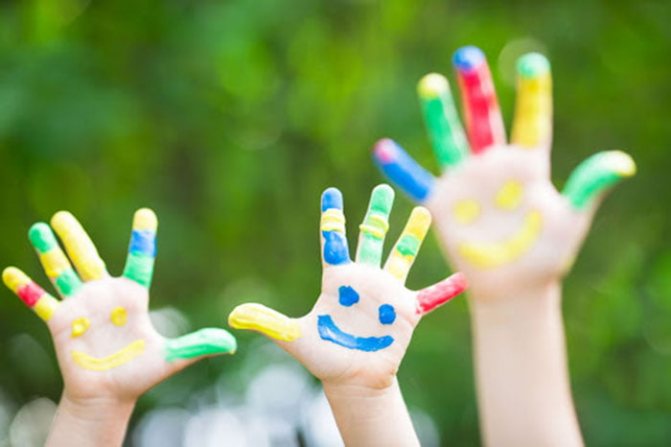
More advanced motor skills activities
- Matches, counting sticks. We collect it, put it in a box, a glass, and build a house out of sticks. A more complicated version: the child collects matches using the same fingers of different hands (two index fingers, two middle fingers, etc.).
- Puzzles and mosaics. The most advanced games-activities for the development of hand-eye coordination, fine motor skills, spatial thinking and speech. At first they can be very large, with a small number of details (you can offer to play with a one-year-old baby). As you grow older, the size of the elements decreases, and their number increases.
The key to success in activities to develop fine motor skills in children is persistence and regularity. It’s good when your baby has the opportunity to practice hand and finger movements every day. If you notice that your child is not doing some movements very well (and at his age they could already), try to come up with as many games and activities as possible to practice this particular movement until it becomes easy, fast and clear.
As you can see, a significant part of the activities listed above are quite simple to organize, they do not require large material or time expenditures on the part of an adult, and they bring not only joy to the child, but also undoubted benefits.
Examples of finger games
So, the development of fine motor skills in children 3–4 years old begins with the simplest games:
- Actively rub your palms and ask your baby to do the same.
- Show your child how siblings greet each other - the fingers of the same name on your hands: touch each other alternately with your little fingers, ring fingers, middle fingers, index fingers and thumbs, telling your baby that this is how brothers greet each other. Let him try again.
- Let the baby imagine that his index and middle fingers are legs that are stomping along a path (for example, into the forest for sweet strawberries). His fingers should precisely walk along the surface of the table.
- And now let him turn into an old grandmother (grandfather) who cannot see well. The doctor prescribed glasses for them (the child uses his thumb and index fingers to pretend to be glasses, bringing them to his eyes).
A little later, when the baby gets used to such exercises, you can start playing with short rhymes, gradually adding longer rhymes and complex movements.
- boat
A hare is swimming in a boat (the child folds his hands in the shape of a boat),
The little bunny calls to swim with him (the baby waves his hands with inviting gestures).
- cat
How painfully does a baby cat bite?
He decided that he saw not a finger, but a mouse!
But I'm playing with you, baby,
And if you start biting, I’ll say: “Come on, shoot!”
When performing this game, the mother takes an old clothespin with a relaxed clamping mechanism so that it does not catch painfully, and “bites” each of the child’s fingers in turn.
- Curlers
The essence of this game is to bend each finger on the baby's hand in turn. To do this, you can use a variety of nursery rhymes. For example, these:
This finger is daddy.
This finger is mommy.
This one here is a grandpa.
This is grandma.
Well, this finger is me.
That's my whole family!
(You need to start counting with your thumb to finish with your little finger)
This brother found a fungus.
It began to cut him.
It was my brother who was frying a mushroom.
This one just ate and ate,
Look how fat he has become!
(Counting, on the contrary, starts with the little finger and ends with the thumb).
